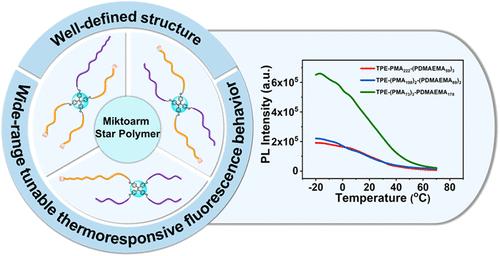热致性 AIE 活性 Miktoarm 星形聚合物:精确合成和结构光致发光
IF 5.2
1区 化学
Q1 POLYMER SCIENCE
引用次数: 0
摘要
实现热响应荧光聚合物的大分子工程策略是实现大范围可调光致发光行为以满足各种应用场景要求的重要途径。本文以简便高效的方法合成了三种具有不同数量溴丙酸和羟基的四苯基乙烯(TPE)衍生物。通过Cu(0)介导的丙烯酸甲酯(MA)单电子转移活自由基聚合(SET-LRP)、羟基向三硫代碳酸基的官能团转化、2-(二甲氨基)甲基丙烯酸乙酯(DMAEMA)向可逆加成-断裂链转移(RAFT)聚合的机理转变,合成了具有明确大分子结构的聚集诱导发射活性mitoarm星TPE-(PMA)n-(PDMAEMA) 4-n (n = 1-3)。由于PMA臂的高临界溶液温度(UCST)行为,TPE-(PMA)n-(PDMAEMA) 4-n在EtOH/H2O混合物中表现出有趣的热响应发射行为。大分子结构对TPE-(PMA)n-(PDMAEMA) 4-n的性能有深远的影响,使其具有高度分化的荧光热响应性。基于变温1H核磁共振和动态激光散射,揭示了其机理。本研究成果对热响应智能荧光系统的合理设计和应用具有重要意义。本文章由计算机程序翻译,如有差异,请以英文原文为准。

Thermoresponsive AIE-Active Miktoarm Star Polymers: Precise Synthesis and Structure-Dependent Photoluminescence
Implementing a macromolecular engineering strategy for thermoresponsive fluorescence polymers is an important approach to a wide-range tunable photoluminescence behavior that meets the requirement of various application scenarios. Herein, three tetraphenylethylene (TPE) derivatives bearing different numbers of bromopropionate and hydroxyl groups were synthesized with simplicity and efficiency. After Cu(0)-mediated single-electron transfer living radical polymerization (SET-LRP) of methyl acrylate (MA), functional group conversion of hydroxyl groups to trithiocarbonate groups, and mechanistic transition to reversible addition–fragmentation chain transfer (RAFT) polymerization of 2-(dimethylamino)ethyl methacrylate (DMAEMA), aggregation-induced emission-active miktoarm star TPE-(PMA)n-(PDMAEMA)4–n (n = 1–3) with a well-defined macromolecular structure were synthesized. Owing to the upper critical solution temperature (UCST) behavior of the PMA arm, TPE-(PMA)n-(PDMAEMA)4–n displayed an intriguing thermoresponsive emission behavior in EtOH/H2O mixtures. The macromolecular structure had a profound influence on the performance of TPE-(PMA)n-(PDMAEMA)4–n, delivering highly differentiated fluorescence thermoresponsiveness. The underlying mechanism was revealed based on variable-temperature 1H nuclear magnetic resonance and dynamic laser scattering. The knowledge gained in our work is important for the rational design and application of a thermoresponsive intelligent fluorescence system.
求助全文
通过发布文献求助,成功后即可免费获取论文全文。
去求助
来源期刊

Macromolecules
工程技术-高分子科学
CiteScore
9.30
自引率
16.40%
发文量
942
审稿时长
2 months
期刊介绍:
Macromolecules publishes original, fundamental, and impactful research on all aspects of polymer science. Topics of interest include synthesis (e.g., controlled polymerizations, polymerization catalysis, post polymerization modification, new monomer structures and polymer architectures, and polymerization mechanisms/kinetics analysis); phase behavior, thermodynamics, dynamic, and ordering/disordering phenomena (e.g., self-assembly, gelation, crystallization, solution/melt/solid-state characteristics); structure and properties (e.g., mechanical and rheological properties, surface/interfacial characteristics, electronic and transport properties); new state of the art characterization (e.g., spectroscopy, scattering, microscopy, rheology), simulation (e.g., Monte Carlo, molecular dynamics, multi-scale/coarse-grained modeling), and theoretical methods. Renewable/sustainable polymers, polymer networks, responsive polymers, electro-, magneto- and opto-active macromolecules, inorganic polymers, charge-transporting polymers (ion-containing, semiconducting, and conducting), nanostructured polymers, and polymer composites are also of interest. Typical papers published in Macromolecules showcase important and innovative concepts, experimental methods/observations, and theoretical/computational approaches that demonstrate a fundamental advance in the understanding of polymers.
 求助内容:
求助内容: 应助结果提醒方式:
应助结果提醒方式:


